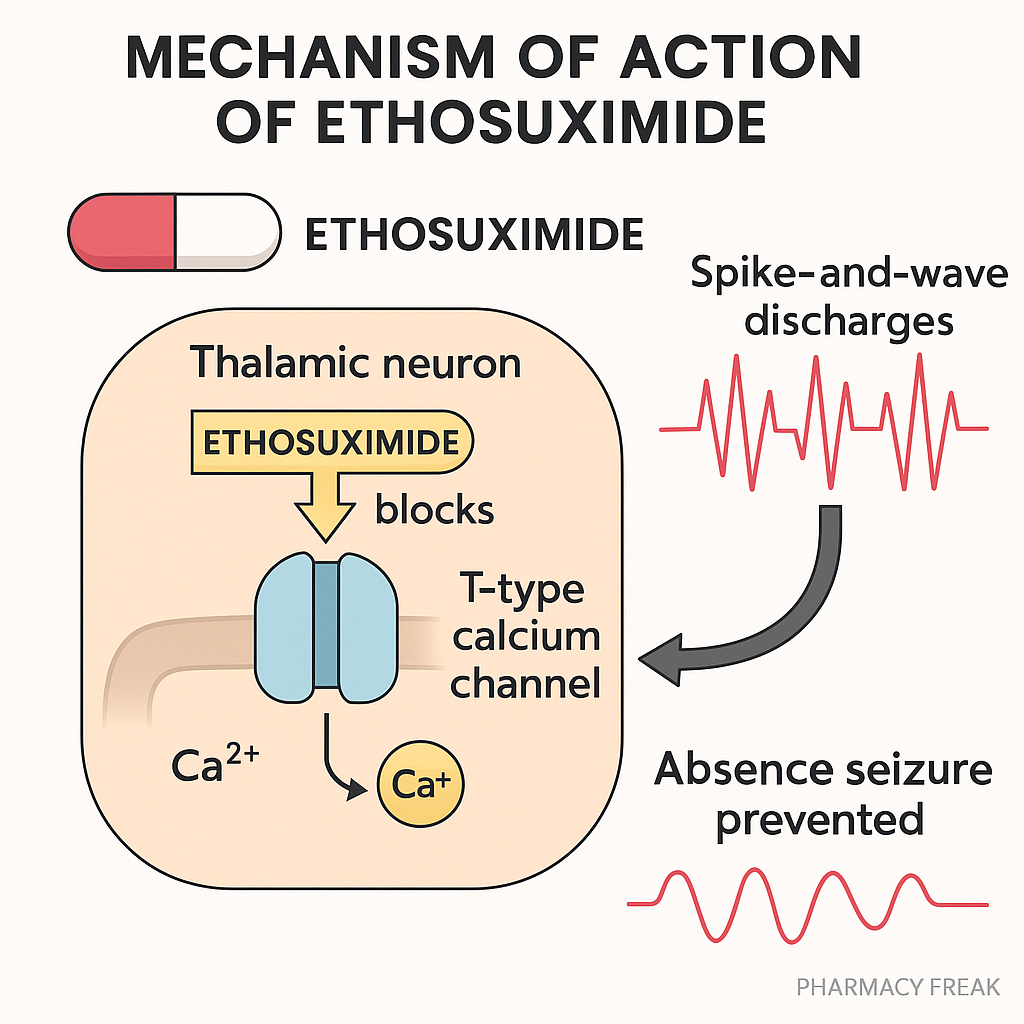Table of Contents
Introduction
Ethosuximide is the first-line drug for treating absence seizures, a type of generalized seizure common in children. It is uniquely effective due to its action on T-type calcium channels in thalamic neurons, which are critical for the pathophysiology of absence seizures. Unlike most other AEDs, ethosuximide is not effective for other seizure types.
It is often tested in exams like USMLE, NCLEX, GPAT, and NEET-PG, particularly in pediatric neurology contexts.
Stepwise Mechanism of Action of Ethosuximide
- Inhibition of T-type Ca²⁺ channels
Ethosuximide selectively blocks low-threshold (T-type) calcium channels in thalamic neurons. - Reduction of rhythmic thalamocortical oscillations
By inhibiting these channels, it reduces oscillatory burst activity that underlies 3-Hz spike-and-wave discharges seen in absence seizures. - Stabilization of thalamic relay neurons
This inhibition stabilizes relay neurons and prevents spread of abnormal cortical rhythms, thereby halting seizure activity.
Pharmacokinetic Parameters of Ethosuximide
| Parameter | Value |
|---|---|
| Bioavailability | ~100% (excellent oral absorption) |
| Half-life | 30–60 hours |
| Metabolism | Hepatic (CYP3A4, CYP2E1) |
| Excretion | Renal (as metabolites) |
| Protein binding | Negligible |
| Therapeutic range | 40–100 μg/mL |
Clinical Uses of Ethosuximide
- Absence seizures (petit mal) – first-line drug
- Juvenile absence epilepsy – as part of combined therapy
- NOT effective for:
- Generalized tonic-clonic seizures
- Myoclonic seizures
- Focal seizures
Adverse Effects of Ethosuximide
- Gastrointestinal upset – nausea, vomiting, abdominal pain
- Fatigue and drowsiness
- Headache and dizziness
- Hiccups (unique side effect)
- Stevens-Johnson Syndrome (rare but serious)
- Leukopenia (rare)
- Behavioral changes – aggression, irritability (esp. in children)
Comparative Analysis: Ethosuximide vs Valproate
| Feature | Ethosuximide | Valproate |
|---|---|---|
| Mechanism | T-type Ca²⁺ channel blocker | Na⁺ blocker + GABA enhancer + T-type Ca²⁺ blocker |
| First-line for absence | Yes | Yes (if mixed seizure types) |
| Spectrum | Narrow | Broad |
| Teratogenicity | Low | High |
| GI upset | Common | Common |
| Mood effects | Rare | More frequent |
Practice MCQs
Q1. Ethosuximide primarily acts on:
a. Sodium channels
b. GABA-A receptors
c. T-type calcium channels ✅
d. NMDA receptors
Q2. The preferred use of ethosuximide is in:
a. Tonic-clonic seizures
b. Absence seizures ✅
c. Status epilepticus
d. Myoclonic epilepsy
Q3. A unique side effect of ethosuximide is:
a. Rash
b. Gingival hyperplasia
c. Hiccups ✅
d. Hyperkalemia
Q4. Ethosuximide inhibits which brain region predominantly?
a. Cortex
b. Basal ganglia
c. Thalamus ✅
d. Hippocampus
Q5. Ethosuximide is ineffective in:
a. Absence seizures
b. Focal seizures ✅
c. Juvenile absence epilepsy
d. Childhood absence epilepsy
Q6. Which seizure pattern is most responsive to ethosuximide?
a. Polyspike wave
b. 3-Hz spike-and-wave ✅
c. Tonic burst suppression
d. Slow wave
Q7. Ethosuximide has minimal interaction with:
a. CYP450 enzymes ✅
b. GABA receptors
c. Dopamine pathways
d. Histamine receptors
Q8. What is the half-life of ethosuximide?
a. 3–6 hours
b. 6–12 hours
c. 30–60 hours ✅
d. Over 72 hours
Q9. Which drug is preferred if absence seizures co-exist with generalized seizures?
a. Phenytoin
b. Valproate ✅
c. Phenobarbital
d. Gabapentin
Q10. Ethosuximide is metabolized by:
a. UGT
b. CYP3A4 and CYP2E1 ✅
c. CYP2D6
d. Not metabolized
FAQs
Q1: Can ethosuximide be used in tonic-clonic seizures?
No, it is not effective for tonic-clonic seizures.
Q2: Why is ethosuximide preferred in absence seizures?
Because it specifically targets thalamic T-type calcium channels, key in absence seizure generation.
Q3: Is therapeutic drug monitoring needed?
Yes, plasma levels can be monitored to ensure efficacy (range: 40–100 μg/mL).
Q4: Is ethosuximide safe in children?
Yes, it is first-line for pediatric absence seizures, with appropriate monitoring.
Q5: Can ethosuximide cause behavioral changes?
Rarely, some children may experience irritability or aggression.
References
- KD Tripathi – Essentials of Medical Pharmacology
- Goodman & Gilman – The Pharmacological Basis of Therapeutics
- Sparsh Gupta – Review of Pharmacology
- NCBI: https://www.ncbi.nlm.nih.gov/books/NBK499963/

I am pursuing MBA in pharmaceutical management from NIPER Hyderabad with a strong academic record and proven success in national-level pharmacy entrance exams. I secured AIR 61 in NIPER 2024 (MS/M.Pharm) and AIR 27 in NIPER MBA, along with AIR 147 in GPAT 2024 and AIR 907 in GPAT 2023. I also achieved AIR 6 in AIIMS CRE-2025 for Drug Store Keeper and was selected as a Pharmacist (AIR 61) for ESIC. Additionally, I was the Runner-Up in Round 2 of the EY Case Study Competition.
At PharmacyFreak.com, I aim to guide future pharmacists through expert content, exam strategies, and insightful resources based on real experience and academic excellence.
Mail- harsh@pharmacyfreak.com

